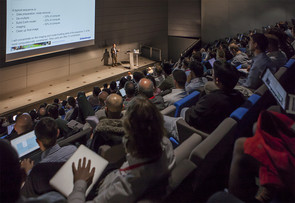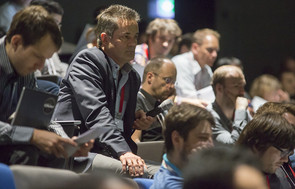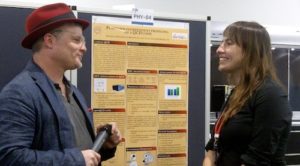 Scientists from a wide range of disciplines gathered at the SwissTech Convention Center in Lausanne from 8 to 10 June 2016 for this year’s PASC Conference. The use of high-performance computing in their research was the common bond that brought them together.
Scientists from a wide range of disciplines gathered at the SwissTech Convention Center in Lausanne from 8 to 10 June 2016 for this year’s PASC Conference. The use of high-performance computing in their research was the common bond that brought them together.
Unlike previous editions of this event, the third PASC Conference was held not at ETH Zurich, but at EPFL in Lausanne. From 8 to 10 June, the SwissTech Convention Center played host to around 360 scientists from Europe, the USA, Canada, Japan, Russia, Saudi Arabia, South Africa and Singapore, offering plenty of space and scope for them to engage in an interdisciplinary discourse on current issues relating to scientific computing.
The three-day programme featured more than 150 talks, comprising invited plenaries, subject-specific minisymposia, contributed talks, and a track devoted to peer-reviewed papers that were published in the Digital Library of the Association for Computing Machinery (ACM). The program was supplemented by around 50 poster presentations. The support from ACM was recognition of the high quality of the technical program and the increased international outlook of the conference.
Fast-track publication via the ACM Digital Library
The key scientific domains explored this year once again included climate and weather, computer science and mathematics, engineering, life sciences, materials, physics and solid earth dynamics, while big data was featured as an emerging domain. The ability of the PASC Conference to bring together such a vast range of scientific disciplines makes it a rather unique platform, and, since the various fields involved tend to adopt different approaches to publication, a novel process was required for publishing the full papers presented at the conference. For example, while domain science communities generally publish in peer-reviewed journals, computer science publishes in peer-reviewed, highly-selective conferences, says Torsten Hoefler, co-chair of the papers committee for PASC16. “In fact, publishing in competitive conferences in computer science is often more highly regarded than journal publication, while this is the opposite in other sciences where conferences are typically non-selective and are seen mainly as networking events and not as a serious publishing venue.”
 To combine the strengths of conference and journal publication schemes, four non-standard key ideas formed the basis of the review process for PASC16. First of all, there was no pre-selected committee: the papers co-chairs, David Keyes from King Abdullah University of Science and Technology in Saudi Arabia and Torsten Hoefler from ETH Zurich, simply appointed editors for scientific areas, allowing them to select appropriate experts in the field for each submitted paper. Secondly, authors were given the opportunity to revise their manuscripts based on reviewer feedback (not usually possible in conference schemes, due to short turnaround times). Thirdly, a full double-blind reviewing approach was implemented, where neither the reviewers nor the co-chairs knew the identities of the authors. And, last but not least, there was an option available for reviewers to suggest additional experts to referee revised manuscripts in a second round of review. Ultimately, twelve of the forty paper submissions were accepted for publication. They were then grouped into three sessions for PASC16: computational mechanics, solvers, and libraries and graphs.
To combine the strengths of conference and journal publication schemes, four non-standard key ideas formed the basis of the review process for PASC16. First of all, there was no pre-selected committee: the papers co-chairs, David Keyes from King Abdullah University of Science and Technology in Saudi Arabia and Torsten Hoefler from ETH Zurich, simply appointed editors for scientific areas, allowing them to select appropriate experts in the field for each submitted paper. Secondly, authors were given the opportunity to revise their manuscripts based on reviewer feedback (not usually possible in conference schemes, due to short turnaround times). Thirdly, a full double-blind reviewing approach was implemented, where neither the reviewers nor the co-chairs knew the identities of the authors. And, last but not least, there was an option available for reviewers to suggest additional experts to referee revised manuscripts in a second round of review. Ultimately, twelve of the forty paper submissions were accepted for publication. They were then grouped into three sessions for PASC16: computational mechanics, solvers, and libraries and graphs.
Supporting science through visualization
 As was the case in previous years, a particular highlight of the conference was the series of invited plenary presentations. The public lecture given by Chris Johnson from the University of Utah, for example, transported the audience into the colorful world of imaging in supercomputing. As the founding director of the Scientific Computing and Imaging (SCI) Institute, Johnson is a specialist in visualization – the visual depiction of bits and bytes calculated by a supercomputer. His presentation shows once again the importance of visualizations and the impact this has on improving our understanding of simulations and which boost it can provide for science. He cited the example of a procedure carried out on Parkinson’s patients who suffer from severe shaking, whereby a probe is inserted into their brain to prevent these tremors. The process of finding the right place to insert the probe into the exposed brain for what is known as “deep brain stimulation” often takes several hours, and during this time the patient is kept awake to ensure that the right area is found. If the simulations proposed by Johnson help to significantly reduce this operating time, the inevitable conclusion drawn is that visualization – as a unique form of data analysis – could one day stand side by side with theory, experimentation and simulation as one of the key pillars of science.
As was the case in previous years, a particular highlight of the conference was the series of invited plenary presentations. The public lecture given by Chris Johnson from the University of Utah, for example, transported the audience into the colorful world of imaging in supercomputing. As the founding director of the Scientific Computing and Imaging (SCI) Institute, Johnson is a specialist in visualization – the visual depiction of bits and bytes calculated by a supercomputer. His presentation shows once again the importance of visualizations and the impact this has on improving our understanding of simulations and which boost it can provide for science. He cited the example of a procedure carried out on Parkinson’s patients who suffer from severe shaking, whereby a probe is inserted into their brain to prevent these tremors. The process of finding the right place to insert the probe into the exposed brain for what is known as “deep brain stimulation” often takes several hours, and during this time the patient is kept awake to ensure that the right area is found. If the simulations proposed by Johnson help to significantly reduce this operating time, the inevitable conclusion drawn is that visualization – as a unique form of data analysis – could one day stand side by side with theory, experimentation and simulation as one of the key pillars of science.
The conference drew to a close with an almost palpable sense of optimism. The engaging talks and variety of discussions and debates left a positive impression on the participants, and many expressed a desire to have a larger number of invited plenary presentations at PASC17 in Lugano (26-28 June 2017). After all, with such a heterogeneous audience, plenary sessions are ideal for building bridges between the various disciplines involved and providing opportunities for dialogue on key issues.
Source: CSCS



